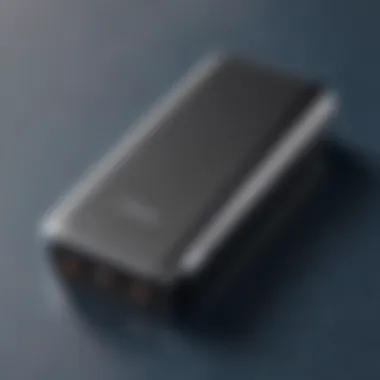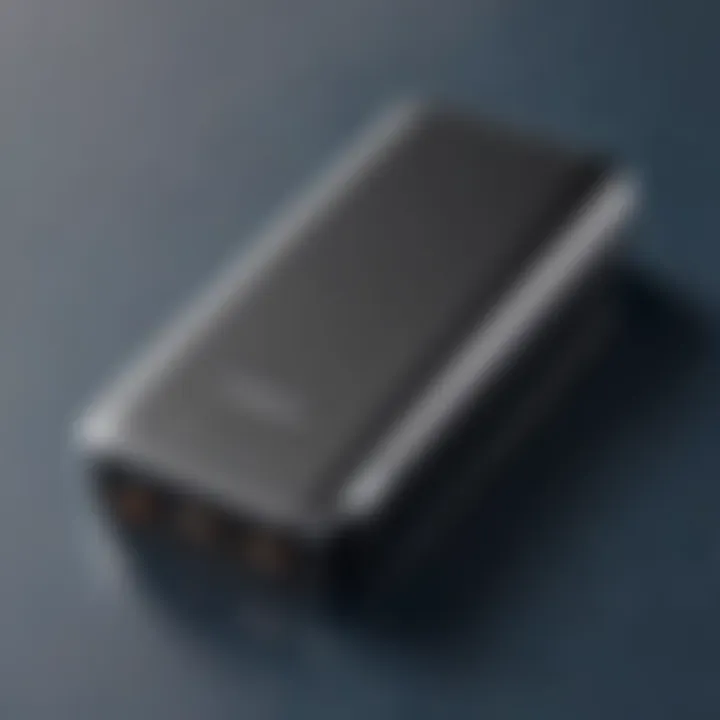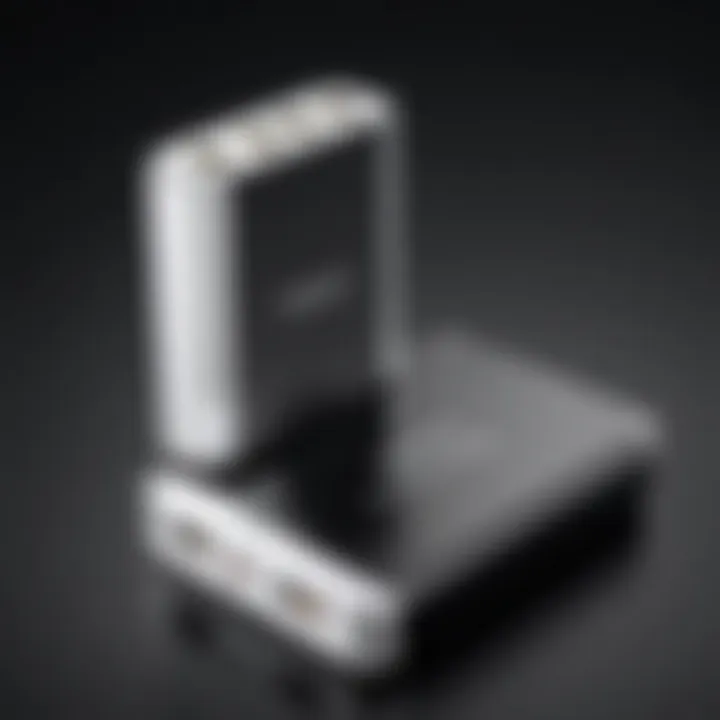Lightweight Portable Chargers: Key Insights and Trends


Intro
In an age where staying connected is non-negotiable, portable chargers have become an essential tool in the tech-savvy individual’s arsenal. Particularly for IT professionals and tech enthusiasts, finding a lightweight and efficient charger can make a world of difference in day-to-day activities. With the rapid pace at which technology evolves, understanding what makes an optimal portable charger is crucial for informed purchasing decisions.
The right charger can mean the difference between powering through a busy workday or searching for an outlet in the middle of a critical task. The significance of this topic extends beyond mere convenience; it touches on the very core of productivity and efficiency. In this comprehensive overview, we will delve into essential features and performance metrics, while also discussing market trends that inform the choices available today.
Readers interested in the nitty-gritty of portable chargers will find valuable insights into the nuances of capacity, compatibility, design, and the overall user experience. With the added promise of discussing notable products and suggesting what might work best in various contexts, this guide is designed to serve both personal and professional needs.
As we journey through this guide, expect to encounter detailed performance analyses, technical specifications, and real-world use cases that shed light on how these chargers function in everyday scenarios. Understanding these elements can elevate one’s tech game significantly, ensuring that you never find yourself scrambling for power again.
Understanding Portable Chargers
The landscape of technology today is moving at a lightning pace, and with it, our reliance on mobile devices has surged. Whether it’s for work or leisure, having a dependable portable charger can be a lifeline when you're on the go. The significance of understanding portable chargers cannot be overstated; it's not just about keeping your devices powered up, it’s about enhancing productivity, ensuring communication, and enjoying the freedom of mobility without the fear of a dead battery hanging over your head.
Definition and Importance
A portable charger, often referred to as a power bank, is a battery pack designed to charge devices without needing a direct connection to a power outlet. These gadgets have become essential for anyone who regularly uses smartphones, tablets, or other battery-operated tech. For IT professionals and tech enthusiasts alike, these chargers represent not only a convenience but also a necessary tool to manage device lifecycles effectively.
Consider the following factors when thinking about portable chargers:
- Mobility: The primary allure of a portable charger lies in its ability to offer power on the move. It’s especially useful for travelers and professionals who often find themselves without convenient access to wall sockets.
- Versatility: Many portable chargers are equipped with various ports, allowing you to charge multiple device types from one power source.
- User Control: Users can monitor their power consumption, making informed decisions on when to recharge their devices versus using a portable solution.
Understanding portable chargers helps users to navigate the offerings in the market more effectively, ensuring decisions are based on needs and device compatibility rather than trendy features that may not provide practical benefits.
Evolving Technology in Portable Power
The technology behind portable chargers has come a long way in recent years. Gone are the days of bulky, inefficient battery packs. Now, manufacturers are prioritizing not just capacity but efficiency and charging speed. Some salient advancements include:
- Lithium Polymer Batteries: These modern batteries are lighter and slimmer than traditional lithium-ion alternatives, allowing for more sleek designs without sacrificing power.
- Fast Charging Technologies: With the development of quick charge protocols like Qualcomm Quick Charge and USB Power Delivery, charging times have dramatically reduced. Some chargers can bring a phone from empty to half-full in under 30 minutes, an incredible feat compared to older models.
- Smart Features: Many portable chargers now come equipped with intelligent technology that recognizes the connected device and adjusts the charging speed accordingly. This ensures optimal charging without damaging the device’s battery.
As we review the latest models, it becomes clear that the investment in a quality portable charger is not just about carrying an extra battery. It’s about embracing technology that keeps pace with our needs in an ever-demanding digital world.
"A power bank isn’t just a product; it’s a bridge to uninterrupted connectivity and productivity."
Understanding portable chargers and their evolving technologies empowers users to make informed decisions—ensuring that their gadgets perform optimally without missing a beat.
Key Features of Lightweight Portable Chargers
When it comes to lightweight portable chargers, understanding the key features can make a world of difference. These gadgets are more than just a backup power solution; they are essential tools for those constantly on the move. For tech enthusiasts and IT professionals alike, knowing what to look for in a portable charger can maximize convenience and efficiency. The topic covers various aspects, including capacity, charging speed, compatibility, size, weight, durability, and design. Each feature plays a pivotal role in determining which charger best aligns with an individual’s needs and the nature of their devices.
Capacity and Recharge Cycles
The capacity of a portable charger, often measured in milliamp hours (mAh), is a critical element. A higher mAh rating typically means more power stored, allowing for multiple device charges. For instance, a portable charger with a capacity of 10,000 mAh can fully recharge a smartphone two to three times, while a 20,000 mAh device can handle even the most power-hungry tablets.
Understanding recharge cycles is equally important. Most power banks have a limited number of times they can be recharged before their effectiveness begins to wane. Many portable chargers can handle anywhere from 300 to 500 recharge cycles. Opting for a charger with a better cycle count can lead to longer usage periods, making it a savvy choice for users who demand reliable performance.
Charging Speed and Output Power
Next up is charging speed, typically indicated by the output power specified in volts and amps. Generally, a higher output means faster charging times, enabling users to keep pace with their busy lifestyles.
Quick Charge technology has become prominent in recent years. Some models support this feature, allowing devices compatible with quick charging to get powered up significantly faster than standard chargers. For example, a charger with an output of 18W might recharge a phone in under an hour compared to several hours with a traditional 5W charger. Therefore, if speed is of the essence, checking for such features is crucial.
Compatibility with Devices


Having a charger that works seamlessly across a spectrum of devices is vital. Many portable chargers now come with multiple output ports, like USB-A and USB-C, which offer flexibility. This compatibility can prove handy when charging not just smartphones, but also tablets, smartwatches, and even laptops.
Moreover, some portable chargers come equipped with built-in cables for even more convenience. The downside here is that not all devices support the newest charging standards. Therefore, ensure the charger matches the specifications of your devices to avoid compatibility headaches down the line.
Size and Weight Considerations
Size and weight cannot be overlooked when discussing portable chargers. After all, portability is at the heart of these gadgets. While there are larger capacity power banks, they tend to be bulkier and heavier. A smaller, lighter charger may sacrifice some capacity but can be easier to carry around and more convenient for daily use.
It's essential to strike a balance here. Weighing the importance of capacity against portability will ultimately depend on individual user preferences and their routine. For example, someone frequently traveling may opt for a lightweight model, while someone who often finds themselves away from a power source for long periods may prioritize capacity over weight.
Durability and Design
Finally, durability and design can significantly impact user experience. A portable charger should not only be functional but also withstand the rigors of daily life. Look for models made from high-quality materials with added features like rubberized bumpers or water resistance.
Moreover, aesthetic considerations play a role, too. Sleek, modern designs can complement professional settings, whereas more rugged styles may appeal to outdoor enthusiasts. Consider how you'll use the charger and choose a design that fits that style.
"The right portable charger should be like a trusted companion—always there when you need it, but not a burden when you don’t."
Performance Metrics
Understanding performance metrics is crucial for discerning the value of lightweight portable chargers in an ever-evolving tech landscape. These metrics offer insights into how well a charger performs in real-world scenarios, ultimately affecting user satisfaction and device compatibility. The importance of these metrics can’t be overstated, especially for IT professionals and tech enthusiasts, who depend on reliable charging solutions to keep their devices running smoothly.
Key performance metrics to consider include charging speed, capacity, and reliability under different usage conditions. Evaluating these aspects will not only guide users in selecting the right charger but also help them tailor their choices to meet specific needs. When consumers equip themselves with this knowledge, they’re better positioned to maximize the efficiency of their portable chargers, ensuring that their gadgets stay powered without draining too much time or energy.
"Knowing the right performance metrics not only guides purchasing decisions but also enhances how we interact with technology in our daily lives."
Real-World Performance Testing
Real-world performance testing serves as a fundamental benchmark for evaluating how portable chargers function outside of controlled lab environments. This testing allows users to see how efficiently a charger can compensate for varying battery levels across different devices. It's not enough to know theoretical charging speeds; potential users need to understand how those numbers translate into daily practices.
Several factors play a significant role in determining real-world performance:
- Device Compatibility: Different devices have varied power requirements. A charger that works wonders for a smartphone may not perform similarly with a tablet or laptop.
- Environmental Conditions: Factors like temperature can affect performance. For instance, chargers might underperform at extremes, either too hot or too cold.
- Usage Patterns: If a user consistently multitasks on their device while charging, the real-time performance can differ vastly from a scenario where the device is idle.
Actual tests often involve charging multiple devices under similar conditions to provide a robust understanding of performance in practical, everyday situations. For instance, a 10,000 mAh charger may promise to charge a phone up to three times but in real-world tests, might just get 2.5 full charges instead. Such insights can help users make informed choices based on their unique needs.
Benchmarking Charging Times
Benchmarking charging times is another essential metric when assessing lightweight portable chargers. This process involves measuring how long it actually takes for a device to charge from a specific low battery percentage to full capacity. Users who are pressed for time will find this information particularly useful, as not all chargers deliver on their promises of speed.
When benchmarking charging times, it’s important to conduct tests under consistent conditions. This includes using the same charging cable, adapter, and device settings. Here are some key factors that influence these benchmarks:
- Output Power: Higher output power translates to faster charging. Most lightweight chargers offer varying output levels, typically between 5W to 30W or more.
- Charging Technology: Features like Quick Charge or Power Delivery can significantly reduce charging times. Brands like Anker and RAVPower have models that support these technologies, making them popular among power users.
- Battery Chemistry: The type of battery in the device being charged also impacts how quickly it can be replenished. Some batteries accept charges faster than others.
Real benchmarks often reveal how different chargers stack up against each other. For example, while one charger may take only two hours to get a device from 20% to full, another charger may need nearly four hours for the same task. Performance metrics such as these allow the informed tech-savvy buyer to select the charger that best fits their pace of life.
Market Trends and Innovations
In today’s fast-paced tech landscape, staying abreast of market trends and innovations surrounding lightweight portable chargers is crucial. It’s not just about having power on the go; rather, it’s about understanding how these new advancements can enhance functionality and user experience. As devices become more powerful and energy-efficient, the demand for smarter, faster charging solutions grows. Thus, exploring these topics unveils key insights for IT professionals and tech enthusiasts alike.
Emerging Technologies in Charging
As technology advances, so do the avenues of charging. Recent innovations have revolutionized the functionality of portable chargers. One notable trend is the rise of fast charging capabilities. Think of it as the espresso shot for your smartphone. No one likes to wait around, and this tech ensures that a quick top-up can save precious time, especially for professionals on tight schedules.


Another emerging technology is the use of USB-C Power Delivery. This innovative protocol allows for higher wattage to be delivered through USB-C connections which means a single charger can power everything from smartphones to laptops. Combining convenience with versatility, it’s as if all your devices decided to play nice together.
Moreover, wireless charging is gaining traction in the portable charger space. Though it may not yet be at the forefront of efficiency, the lack of wires can make for a cleaner and more organized experience. Imagine setting your phone down on a charger without hunting for cables, it's the little things that count, isn’t it?
Sustainability and Eco-Friendly Options
Sustainability isn’t just a buzzword—it’s now a defining characteristic of many modern products. Within the realm of portable chargers, eco-friendliness is gaining momentum.
Many companies are now focusing on making their chargers using recyclable materials. This initiative not only reduces waste but also speaks volumes about a brand’s values. Additionally, advancements in solar-powered chargers are paving the way for a greener approach. Picture yourself hiking up a mountain, basking in the sun while your devices soak in energy to keep you connected. These chargers leverage natural energy, promoting an environmentally friendly lifestyle.
Furthermore, battery recycling programs are popping up as brands encourage consumers to return old chargers for proper disposal or refurbishment. It’s a great example of turning the tide on electronic waste. A clean conscience goes hand in hand with a charged device.
Evaluating Pros and Cons
When it comes to selecting lightweight portable chargers, understanding their advantages and disadvantages is key. This section shines a light on both sides, painting a clear and comprehensive picture. Knowledge of these pros and cons is essential for those who want to make informed decisions, whether for personal use or professional applications. The world of portable power is vast, and a nuanced understanding can simplify the choice when you're faced with numerous options.
Advantages of Lightweight Chargers
Lightweight portable chargers have rapidly gained popularity for several compelling reasons:
- Portability: The most striking advantage is the convenience of carrying these devices. Their lightweight nature means you can easily toss one into your bag or pocket. This flexibility is especially valuable for travelers or anyone constantly on the go.
- Ease of Use: Most lightweight chargers come with user-friendly features, making them accessible even for those not tech-savvy. Plug it in and start charging, simple as that.
- Versatile Compatibility: Many lightweight chargers are designed to be compatible with a broad range of devices—smartphones, earbuds, tablets, and more. This universality prevents the hassle of carrying multiple chargers.
- Cost-Effective Solutions: Generally speaking, these chargers are more affordable than heavier counterparts. They provide a good balance of price and functionality, appealing to budget-conscious consumers.
- Innovative Technology: Recent advancements in battery technology mean that even lightweight chargers can deliver impressive power output. Users can efficiently charge their devices without needing bulky equipment.
In summary, the advantages of lightweight portable chargers combine convenience, affordability, and technological advancement, making them an attractive option for many users.
Disadvantages and Limitations
As beneficial as lightweight portable chargers are, they also come with some drawbacks that potential users should consider:
- Lower Capacity: Many lightweight options have smaller battery capacities than their heavier counterparts. If you're in a situation where you need extended power, these may not be sufficient.
- Durability Concerns: Constructed from lighter materials, these chargers might not withstand rugged conditions as well as heavier variants. Users who demand high durability need to keep this in mind.
- Speed Limitations: While charging speeds can be quite good, some lightweight chargers may not be able to deliver the rapid charging capabilities of their more robust counterparts. For quick top-ups, this can be a disadvantage.
- Heat Management: Some models are prone to heating during operation. This can be a problem not only for the charger itself but also for the devices being charged — overheating can lead to battery damage.
- Fewer Features: Generally speaking, lightweight chargers may lack certain advanced features seen in bulkier models, such as integrated cables, additional ports, or built-in displays. This could limit their functionality depending on user needs.
To sum up, while lightweight portable chargers offer undeniable benefits, potential drawbacks exist that must be weighed. Balancing these pros and cons will empower users to choose a charger that best fits their lifestyle and charging needs.
Top Recommendations
When it comes to lightweight portable chargers, selecting the right device can be quite the pickle. With a saturated market, it becomes essential for consumers to navigate through various specs and features to find the best fit for their needs. This section narrows down standout products, taking into account not just performance metrics and features but also how well they align with users' unique lifestyles and demands. Here, we discuss the most reliable options – each catering to different needs, whether you’re a frequent traveler, a budget-conscientious buyer, or looking for a top-tier choice that doesn’t compromise on quality.
Best Overall Lightweight Charger
In the realm of portable chargers, the Anker PowerCore Slim 10000N emerges as a crowd favorite. This charger strikes a balance between capacity and compactness; weighing in at just over 200 grams, it's light enough to toss into a backpack yet powerful enough to charge a smartphone multiple times. The PowerIQ and VoltageBoost technologies ensure rapid charging, making it suitable for those in a hurry. Plus, the sleek design doesn't scream "I'm a charger" when it's nestled in your bag.
Best Budget Option
For those keeping a close eye on their wallets, the RAVPower 10000mAh Portable Charger stands out as an excellent budget-friendly choice without sacrificing performance. A well-made product, this charger offers dual USB ports, enabling simultaneous charging of multiple devices. Users often rave about its efficiency, reported to provide around 2.5 charges for most smartphones. Moreover, the quality feels robust, bucking the stereotype of cheap chargers being flimsy.
Best Premium Charger
On the luxury end of the spectrum, the Mophie Powerstation XXL is the heavyweight champion. With 20,000mAh of capacity, you can bet this beast will keep your devices alive on long trips or busy workdays. Mophie’s reputation for quality shines through its design, which is both elegant and functional. The premium price tag reflects features like wireless charging, a sleek finish, and multiple output ports to charge a tablet alongside your smartphone. This charger doesn’t just meet expectations; it exceeds them.
Best for Travel
Frequent travelers require something that not only charges devices but also takes up minimal space. The Zendure A2 Portable Charger checks all the boxes for travel-related concerns. Weighing in close to a pound, it’s compact, rugged, and built to withstand the rigors of travel. With 10,000mAh stored away, it can recharge a smartphone up to three times, allowing for peace of mind while on the go. Moreover, it offers a unique pass-through charging feature, meaning you can pack it up while it’s charging, an absolute win for road warriors.
"A portable charger should be the least of your concerns while traveling; it should just work, and the Zendure A2 allows you to do just that."


Each of these recommendations reflects a keen understanding of user needs, whether it's weight, budget, or extra features. This comprehensive overview aims to guide you in making an informed decision tailored to your individual circumstances.
User Experiences and Feedback
In the realm of portable chargers, user experiences and feedback hold significant weight. This section shines a light on the real-life applications and implications of using lightweight portable chargers, emphasizing how they fit into the day-to-day hustle of tech-savvy individuals. By examining user perspectives, we gain a clearer understanding of what works well and what does not, allowing prospective buyers to make informed decisions. Moreover, this feedback taps into the collective intelligence of experiences, providing valuable insights into performance metrics, usability, and longevity.
Case Studies and Testimonials
Real-world case studies and testimonials from users create an authentic narrative around lightweight portable chargers. Consider the experience shared by Jenna, a digital nomad who travels frequently for work. She states that her choice of the Anker PowerCore Slim 10000 has been pivotal in keeping her devices charged during long flights and while working remotely. She praises its slim profile, saying it fits comfortably in her handbag without adding unnecessary bulk.
Similarly, let’s take David’s experience with the RAVPower 20000mAh Power Bank. A software engineer who often works outdoors, he appreciates its substantial capacity and fast charging feature. He reported that it can power his laptop and smartphone multiple times on a single charge, proving its reliability during remote projects.
Testimonials like these highlight specific elements that enhance the user experience—for instance, capacity, design, and charging speed—as these factors often dictate the efficiency of a portable charger in practical scenarios.
"I never realized how essential a lightweight charger was until I faced a dead battery in the middle of a client meeting. Now, it’s a necessity I can’t live without." – Sarah, IT Consultant.
Common Issues and Solutions
While user experiences can be overwhelmingly positive, it’s also crucial to address the common issues that arise with lightweight portable chargers. Many users note that heat generation during charging is a concern, especially when using fast charging features. For example, Emily, a university student, noted that her Belkin Pocket Power 10K became uncomfortably warm after several hours of use.
A solution to this issue is ensuring proper ventilation during charging and avoiding using the charger while it is also being charged, which can exacerbate heat issues. Additionally, investing in chargers with integrated heat management systems can mitigate these effects significantly.
Another common issue mentioned by users is compatibility with certain devices. Greg, a mobile gamer, discovered that his portable charger struggled with his high-performance smartphone. To avoid such pitfalls, it’s advisable to check manufacturer documentation on compatibility and output ratings.
In addressing these challenges, potential buyers can better align their choices with their specific needs, enhancing overall satisfaction with their purchasing decision. Utilizing online platforms, forums, or reviewing resources on sites like reddit.com can also provide insights and help navigate these common pitfalls.
Maintenance and Best Practices
Maintaining your lightweight portable charger is not merely a recommendation; it's an essential practice that can significantly enhance both the lifespan of the device and your overall user experience. Many people underestimate the role of regular care, which can lead to performance issues, decreased battery life, or even device failure. With the rising dependence on mobile technology, knowing how to keep your portable charger in prime condition is key.
Proper Usage Guidelines
When it comes to the effective use of light portable chargers, there are several guidelines that one should follow:
- Avoid full depletion: It's wise not to let your portable charger drain completely before recharging. Lithium-ion batteries thrive from partial charges and discharges. Keeping your battery level between 20% and 80% can greatly extend its life.
- Use the right cables: Not all charging cables are created equal. Use cables specifically designed for your charger to avoid compatibility issues and enhance charging efficiency. Mismatched cables can result in slower charging rates or, in the worst case, damage your device.
- Monitor temperature: Just like us, batteries dislike extreme temperatures. Using your charger in overly hot or very cold environments can affect its efficiency and longevity. It's best to operate and store the device in temperature-controlled environments.
“An ounce of prevention is worth a pound of cure.” This adage rings true for portable charger maintenance. Following usage guidelines can prevent future headaches.
Storage and Care Tips
Storing your portable charger properly is just as important as using it correctly. Here are some vital storage tips:
- Keep it clean: Dust and debris can obstruct ports and reduce conductivity. Regularly clean your charger using a soft cloth and avoid using liquid cleaners that can seep into openings.
- Avoid long-term storage when fully charged: If you plan not to use your charger for an extended period, it's best to store it at a charge level around 50%. This balance helps prevent the battery from degrading over time.
- Use protective cases: If you often toss your charger into bags or on desks, consider investing in a protective case. This minimizes physical damage from drops or scrapes.
Following these maintenance steps ensures that your lightweight portable charger not only meets your immediate needs but also stands the test of time in this fast-paced digital world.
Future Outlook
The realm of lightweight portable chargers is ripe for transformation, especially as technology rapidly advances. The importance of examining the future outlook in this article cannot be overstated. As we delve into this topic, we identify specific elements that will shape the evolution of these essential gadgets. Understanding these trends is crucial for IT professionals and tech enthusiasts who seek to stay ahead of the curve.
Key Considerations:
- Technological Advancements: We are witnessing continual progress in battery technology, particularly regarding energy density and charging efficiency. New developments promise not only improvements in how much power can be packed into a lighter frame but also enhancements in how quickly devices can recuperate their charge.
- User-Centric Designs: Tech users are increasingly prioritizing portability without compromising durability. Future chargers will likely incorporate more rugged materials that withstand harsh environments while maintaining lightweight properties.
- Eco-Friendly Innovations: There’s a growing trend towards sustainability. The push for greener technology means that manufacturers will need to focus on creating recyclable and energy-efficient charging solutions, appealing to environmentally conscious consumers.
Ultimately, being informed about these trends allows users to make educated decisions, ensuring that their portable chargers remain functional and relevant in a fast-paced, tech-driven world.
Predictions for Portable Charger Technologies
As we look forward, here are some specific predictions about the future of portable charger technologies:
- Increased Capacity: Expect chargers that offer even higher capacities while remaining compact. Innovations in lithium-sulfur and solid-state batteries may drive this development.
- Rapid Charging Solutions: Fast charging will likely become a standard expectation rather than a luxury, with advancements in protocols such as USB Power Delivery becoming more widespread.
- Smart Features: Integration of smart technology is on the rise. Look for chargers that automatically detect device requirements or have built-in management systems to optimize charging times and cycles.
- Wireless Charging Evolution: The convenience of wireless charging will see enhancements in efficiency and reach, meaning devices can charge without direct contact.
- Multi-Device Compatibility: Many future models will likely support charging multiple devices at once, catering to users with various gadgets. This flexibility will be paramount as users juggle work and personal tech.



